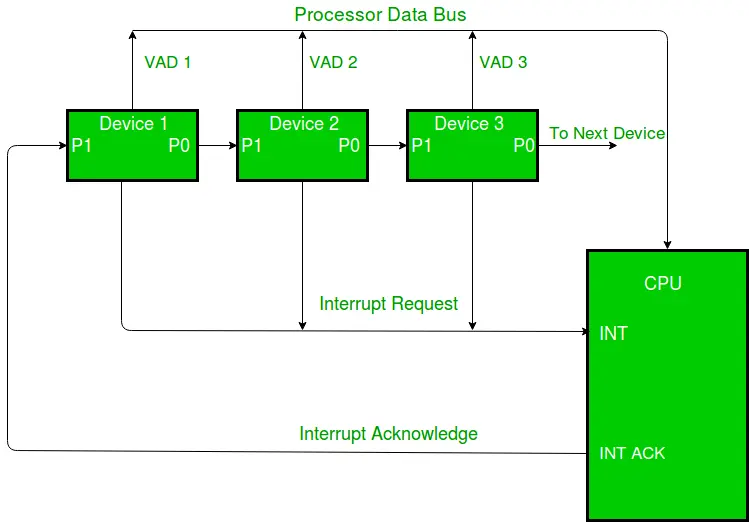
Daisy Chaining for Interrupts: Concept, Working, Advantages and Limitations
When multiple I/O devices are connected to a processor, several may raise interrupt requests at the same time. The CPU needs a way to prioritize and identify which device’s request should be served first.
One common method to achieve this is Daisy Chaining, widely asked in Computer Organization & Architecture questions in competitive exams.
What is Daisy Chaining?
Daisy Chaining is a hardware method of assigning priority to I/O devices in an interrupt system.
All devices are connected in a serial chain (like links in a daisy chain).
The processor sends a common interrupt acknowledge signal through the chain.
The device with the highest priority (nearest to the CPU in the chain) gets the first chance to respond.
If it does not raise an interrupt, the signal is passed to the next device, and so on.
Working of Daisy Chaining (Step-by-Step)
Interrupt Request – One or more devices raise an interrupt.
Processor Acknowledgment – CPU sends a single INTA (Interrupt Acknowledge) signal.
Device Checking –
The signal enters the first device in the chain.
If that device has raised the interrupt, it captures the acknowledgment and sends its interrupt vector to the CPU.
If not, it passes the acknowledgment to the next device.
Interrupt Handling – CPU executes the Interrupt Service Routine (ISR) of the identified device.
👉 Thus, priority is decided by physical position in the chain (closer = higher priority).
Block Diagram of Daisy Chaining (Conceptual)
Device 1 has highest priority, Device N has lowest.
Advantages of Daisy Chaining
Simple priority scheme – Hardware-based priority resolution.
Cost-effective – Requires fewer hardware lines than fully independent priority lines.
Scalable for small/medium systems – Easy to add or remove devices.
Disadvantages of Daisy Chaining
Fixed priority – Devices near CPU always get higher priority.
Unfairness – Low-priority devices may starve if high-priority devices frequently interrupt.
Delay in identification – Interrupt acknowledge signal must pass sequentially through each device.
Not suitable for large systems – Latency increases with the number of devices.
Comparison with Other Priority Methods
| Method | How it Works | Pros | Cons |
|---|---|---|---|
| Software Polling | CPU checks each device status via software | Simple, low hardware cost | Slow, time-consuming |
| Daisy Chaining | Devices linked in chain, priority by position | Simple hardware, low cost | Fixed priority, unfair |
| Vectored Interrupts | Each device provides its own interrupt vector | Fast, flexible, fair priority | More complex, costlier |
Applications of Daisy Chaining
Microprocessor-based systems (e.g., Intel 8085/8086 with peripheral devices).
Embedded controllers with limited I/O devices.
Small-scale computing systems where simple priority handling is sufficient.
Important Exam Pointers
Daisy chaining = hardware priority method for interrupts.
Priority depends on physical position in the chain.
Device closest to CPU has highest priority.
Main drawback = starvation of low-priority devices.
Commonly compared with software polling and vectored interrupts.
Conclusion
Daisy chaining is a simple and hardware-efficient technique for handling interrupts from multiple devices. It provides a fixed, position-based priority scheme but suffers from fairness issues. For competitive exams, focus on its working principle, advantages, disadvantages, and comparison with other interrupt handling techniques.